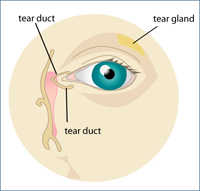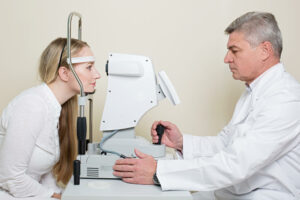Most people who want to get LASIK are great candidates for the surgery. The majority of patients who undergo evaluation for LASIK are approved.
But some get screened out because they don’t qualify for the vision correction procedure. One of the things that can make it challenging to get LASIK is if you have a pre-existing eye condition.
One of the more common eye conditions that LASIK candidates may have is dry eye syndrome. It doesn’t immediately disqualify you as a LASIK candidate if you have dry eye syndrome.
But it does mean that you need to have your dry eye symptoms under control and successfully treated before having LASIK. Keep reading to learn more about dry eye syndrome and LASIK.
Dry Eye Syndrome

Dry eye syndrome is a chronic eye condition. It can be temporary if you’re only dealing with its symptoms periodically, and they don’t become worse.
Dry eye syndrome symptoms include a burning sensation in the eye and the feeling of grit in the eye. You may also experience eye fatigue, light sensitivity, watery eyes, redness, and other discomforts.
It can be very uncomfortable. Undergoing a laser vision correction procedure like LASIK will make your eyes feel more dry than usual. If you have dry eye syndrome and get LASIK, it can be more challenging to recover after the procedure if your symptoms aren’t under control.
It can also make it difficult for your eyes to heal, making them more prone to infection. It isn’t recommended that you have LASIK if you have dry eye syndrome that isn’t under control or currently treated.
Temporary dry eyes may be triggered by certain medications, your environment, or even your diet. If you have chronic dry eye syndrome, it may be caused by another pre-existing condition, dysfunction in the tear glands, or other unidentifiable causes.
This eye condition is more common in women, especially those undergoing hormonal changes like pregnancy or menopause.
You may not know if you have dry eyes if you have a very mild case. But part of having a LASIK evaluation includes assessing how well your eyes produce tears.
LASIK Evaluation
An essential part of a LASIK evaluation involves thoroughly examining your eyes. Part of this exam consists in testing your tears.

Both the quantity and quality of your tears will be tested using specialized equipment. Your eye doctor will also test how well your tears disperse over the surface of your eye.
Dry eye is usually not caused by low tear production but by poor-quality tears. Tears are composed of three parts: water, oil, and mucus.
When there’s not enough of one component, it can affect how well your tears moisturize and lubricate your eye. For example, when the gland that produces the oil that coats the tears with a protective film, the meibomian gland doesn’t function correctly, your tears don’t have that film, so they evaporate too quickly.
If your LASIK evaluation determines that you have dry eye or are at high risk of developing dry eye syndrome due to the quality of your tears, you won’t be approved for LASIK. But there are treatment options that, if successful, can allow you to have LASIK surgery after re-evaluation.
Non-Invasive Treatments
As directed by your eye doctor, you can try some simple treatments for both temporary and chronic dry eye syndrome. One of the first things you should do is look at your environment.

If your home or office is dry due to the AC, it may be affecting your eyes. Go easy on the air conditioning if you can, and consider getting a humidifier. A humidifier is an easy way to put much-needed moisture back in the air if your eyes are too dry.
Dehydration can also contribute to dry eye, so be sure to drink plenty of water. You can also take supplements that contain omega-3 fatty acids, which are needed for healthy tears.
You can get omega-3 from fish oil or flaxseed oil, but it’s always more effective to get your nutrients straight from food. Eat plenty of fish, nuts, and seeds to get more omega-3 in your diet.
At Loden Vision Centers, we offer a treatment called LipiFlow. LipiFlow is a dry eye treatment that massages the eyelids while using warmth, helping to unclog meibomian glands.
This therapy is meant to treat meibomian gland dysfunction. It uses a combination of light and heat to soften blockages in the meibomian gland so the oil it produces can flow freely. It can take a few weeks to see results from this treatment, but it has a high success rate.
If these simple lifestyle changes and non-invasive treatments aren’t effective, there’s also a surgery that may help relieve your dry eye.
Surgical Options

The primary surgical option for dry eye is punctal plugs. This minimally-invasive procedure implant plugs in the puncta, the tear glands in the corner of your eye near your nose. Your tears drain through the puncta, so blocking them off forces tears to stay on the surface of your eye longer.
Chances are, no matter how severe your dry eye symptoms may be, they can be treated to relieve symptoms significantly. If you can fully manage your symptoms, you can safely have LASIK surgery.
Not everyone with dry eyes will be able to have LASIK, but if you try all the treatment options, you’ll likely improve enough to be able to correct your vision. If you can’t, alternative procedures may be safer, like PRK.
Make sure to discuss all options available with your eye doctor during your LASIK evaluation and consultation.
Think LASIK is the answer you’ve been looking for? Learn more by scheduling a LASIK consultation at Loden Vision Centers in Nashville, TN, now!


